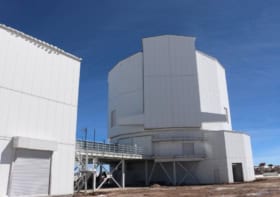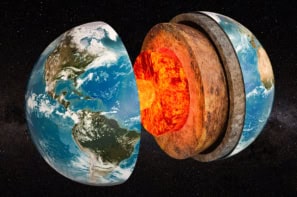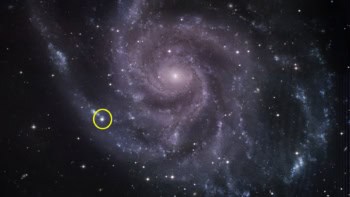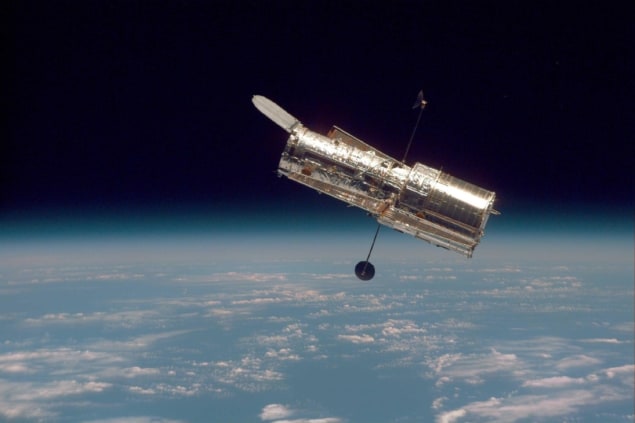
Launched on 24 April 1990, stowed in the payload bay of the space shuttle Discovery, the $1.5bn Hubble Space Telescope experienced a difficult start to life. Unknown to mission engineers, its 2.4 m primary mirror had been ground to incorrect specifications. Remarkably, it was off by just 2 µm, but this was sufficient to cause its optics to be imbued with spherical aberration – a fault that caused the curvature of the mirror to not bring light to focus at the same point. In short, its vision was blurry.
The space telescope was at the forefront of astronomers’ efforts to push further into the final frontier and the error was a public-relations disaster for NASA. Hubble’s impaired vision severely limited its usefulness and derision came in from all quarters, including Maryland senator Barbara Mikulski, who dubbed it a ‘techno-turkey”.
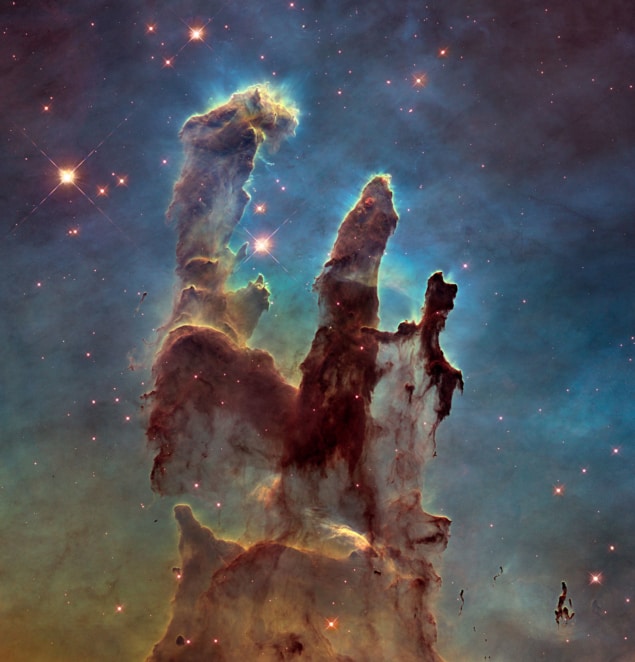
Thankfully, in a daring space walk three years later, astronauts successfully installed the COSTAR instrument, which effectively provided the optical fix to give Hubble its “glasses”. The telescope went on to obtain vast numbers of spectacular images, many of which are now iconic.
These include the Pillars of Creation – towering spires of gas, light-years long, in the star-forming environment of the Eagle Nebula – as well as the Hubble Deep Fields, which show some of the earliest galaxies in the universe.
The last servicing mission to Hubble took place in May 2009 – two years before the space shuttle fleet was retired. That particular mission saw six new gyroscopes installed, which were used to accurately point the telescope.
Since then, however, three of the gyroscopes have failed. Hubble could operate with just two, or even one, gyroscope but there are currently no plans for further repair trips to the craft. So if any of Hubble’s four scientific instruments – the Wide Field Camera 3, the Space Telescope Imaging Spectrograph, the Advanced Camera for Surveys and the Cosmic Origins Spectrograph – experience a catastrophic malfunction and fail, there will be no repairing them.
It is uncertain how long Hubble’s ageing instruments and mechanisms can hold out for. Yet despite being 30 years old, time on the observatory remains highly desirable: over 1000 proposals to use Hubble are received from astronomers each year, only about a sixth of which are granted.
Hubble has brought the universe into people’s homes and it has inspired young people to become scientists and engineers
Antonella Nota
“The competition in the Hubble peer-review system is tough, but this ensures that only the most creative, impactful and scientifically meaningful ideas will actually be implemented and will receive precious Hubble Telescope time,” says Antonella Nota, associate director of the European Space Agency (ESA), who oversees ESA personnel at the Space Telescope Science Institute in Baltimore, US.

Neutrinos provide insight into why matter dominates the universe, celebrating the Hubble Space Telescope’s 30th birthday
And even if the observatory perseveres into the 2030s, it will face a new and deadly danger: atmospheric drag. Orbiting at an altitude of 598 km above the Earth, the Hubble telescope feels the tenuous edges of our atmosphere, and by around 2035 the drag is expected to cause Hubble’s orbit to decay to the point that it re-enters our atmosphere and burns up.
There are, however, options to keep Hubble going. In the 2009 servicing mission, a docking ring was attached to Hubble so that a robotic spacecraft could attach to it and either de-orbit Hubble safely over the ocean or push it up to a higher orbit where it will be safe.
It has been speculated that such a robotic mission could also repair and replace some of Hubble’s instruments, but by then it is likely that Hubble will pass into scientific history. All eyes will then be on its successor, one of which is NASA’s troubled $8.8bn James Webb Space Telescope (JWST).
Cost hikes and delays
Currently scheduled to blast off in March 2021, the JWST has experienced its countless delays and costs overruns that almost led to its cancellation in 2011 by the US House of Representatives Appropriations Committee. Recent launch dates of 2018 and 2019 have also had to be postponed as scientists and engineers grapple with significant technological challenges.
An internal US government report published in January this year poured scorn on even the latest deadline, claiming that there is only a 12% chance that the proposed March 2021 launch date will be met. But once JWST does finally make it into space, Nota at least is convinced it “will be a game-changer”, with its giant 6.5 m segmented mirror able to see the very first galaxies and discover what caused the “re-ionization” of the universe during the first billion years of cosmic history. During that period, ultraviolet light from the first stars and galaxies ionized the fog of neutral hydrogen gas that filled the universe.
The JWST will also be able to probe the atmospheres of nearby exoplanets, potentially capable of discovering biosignatures that could point to the existence of life. “With a sensitivity 100 times that of Hubble” says Nota, “it will show a new and different view of the universe.”
JWST is designed to operate in the near- and mid-infrared – between 0.6–28.5 µm – to probe those distant galaxies and peer into dusty star- and planet-forming zones. It therefore is not a direct replacement for Hubble in the visible and ultraviolet regimes. Nor is another upcoming large space telescope – the Wide Field Infrared Survey Telescope (WFIRST), which is set to launch in 2025.
With a 2.4 m mirror given to NASA by the US National Reconnaissance Office, WFIRST will have a 0.28 square-degree field-of-view, which is 100 times larger than Hubble. This new space telescope will survey vast swathes of the sky at infrared wavelengths. So while it will not replicate the kinds of observations made by Hubble, both it and JWST will strongly complement the veteran space telescope.
Hubble’s real replacement could rather be the Large Ultraviolet, Optical, Infrared Surveyor (LUVOIR). Currently, it is at proposal stage and is competing against three others – the Lynx X-ray Observatory, the Habitable Exoplanet Imaging Mission, and the Origins infrared space telescope – to win backing from the National Science Foundation’s 2020 Decadal Review and to be selected by NASA.
[Hubble] has truly made space-based astronomy accessible in ways that were just not possible before
Antonella Nota
Martin Barstow from the University of Leicester in the UK, who is a member of LUVOIR’s planning team, thinks it could be another five years before NASA decides whether to move forward with the project. “There is [still] work to do on the technology, but NASA has already started to look at this,” he says.
By commissioning detailed reports on the four competing missions, NASA hopes that critical technical challenges can be identified and solved before the mission is selected, with the aim of avoiding the kind of unwelcome surprises that have plagued the development of the JWST. This kind of forward planning is “the difference between NASA’s next flagship [mission] and the previous ones,” adds Barstow.

LUVOIR’s backers face two main technological challenges. One will be to design a highly sensitive coronagraph that can block the light of stars so that LUVOIR can directly image Earth-sized planets orbiting them. The other will be to find ways to fold up its segmented mirror for launch.
But given that coronagraph technology will be pioneered by WFIRST, while the folding mirror is a key part of JWST’s design, then – if all goes well – those two missions should validate the technology needed for LUVOIR. Indeed, the LUVOIR team have planned for two different mirror sizes – 8 and 15 m in diameter – either of which would make LUVOIR the largest space telescope ever built.
Nota, who is also a member of the LUVOIR team, is excited by the possibilities that the telescope offers, describing it as “a spectacular concept with very strong and compelling scientific goals”.
A household name
For the public, however, Hubble will live long in the memory regardless of what triumphs its successors enjoy. “Hubble’s initial history of failure and recovery has struck a chord with the public that no other mission has,” says Nota. “Hubble has brought the universe into people’s homes and it has inspired young people to become scientists and engineers.”
Nota believes that much of this is down to the way Hubble’s observations have been made accessible to everyone – its websites are replete with all its imagery, its data archive available to any astronomer who wants to peruse it, while the images are seen everywhere from mousemats and screen savers to T-shirts and phone backgrounds.
Hubble is a genuine household name. “That is why Hubble is also nicknamed “‘the people’s telescope’,” says Nota. “It has truly made space-based astronomy accessible in ways that were just not possible before.”

